Earlier Works:
All Artwork © Stephen Althouse

Berlin
1997 silver gelatin print 23 x 19 inches, 58 x 48 cm
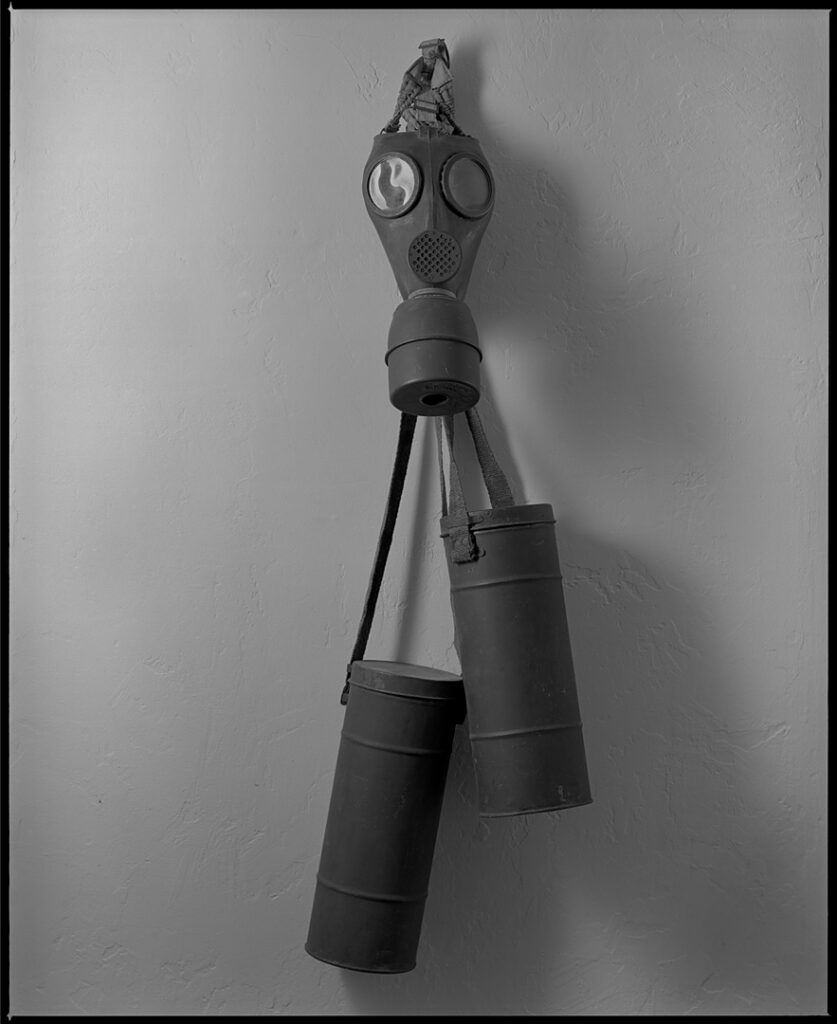
Mask IV
1997 silver gelatin print 23 x 19 inches, 58 x 48 cm
Museum of Art – DeLand, Florida
Maison Européenne de la Photographie, Paris, France

Mask V
1997 silver gelatin print 23 x 19 inches, 58 x 48 cm
Museum of Art-DeLand, Florida
Musée Français de la Photographie, Bièvres, France

Spears
1997 silver gelatin print 23 x 19 inches, 58 x 48 cm

detail – Spears
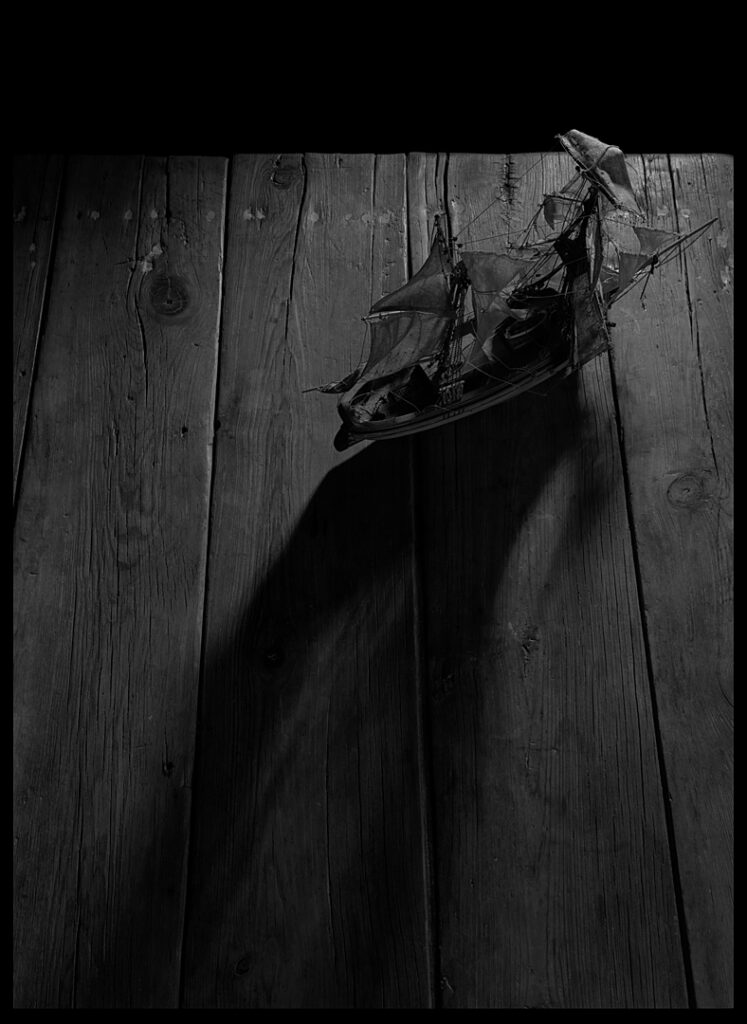
Storm
1997 silver gelatin print 23 x 19 inches, 58 x 48 cm

detail – Storm

Blades III
1997 silver gelatin print 19 x 19 inches, 48 x 48 cm
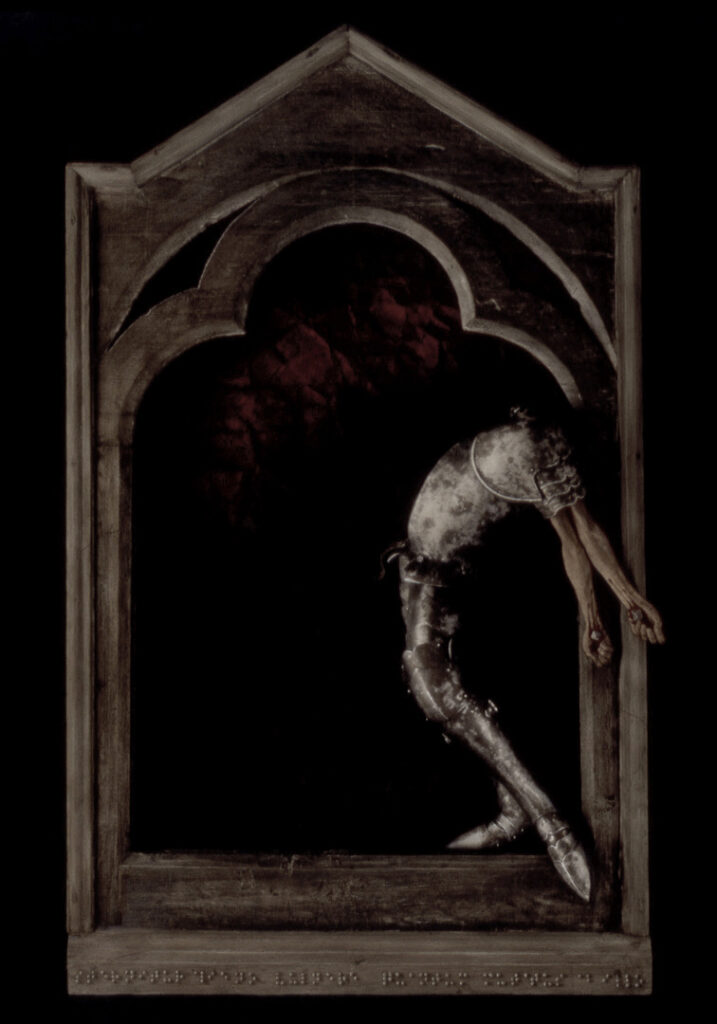
Standing Armor
1995 hand colored silver gelatin print 23 x 17 inches, 58 x43 cm
Kunstmuseum Bern, Switzerland
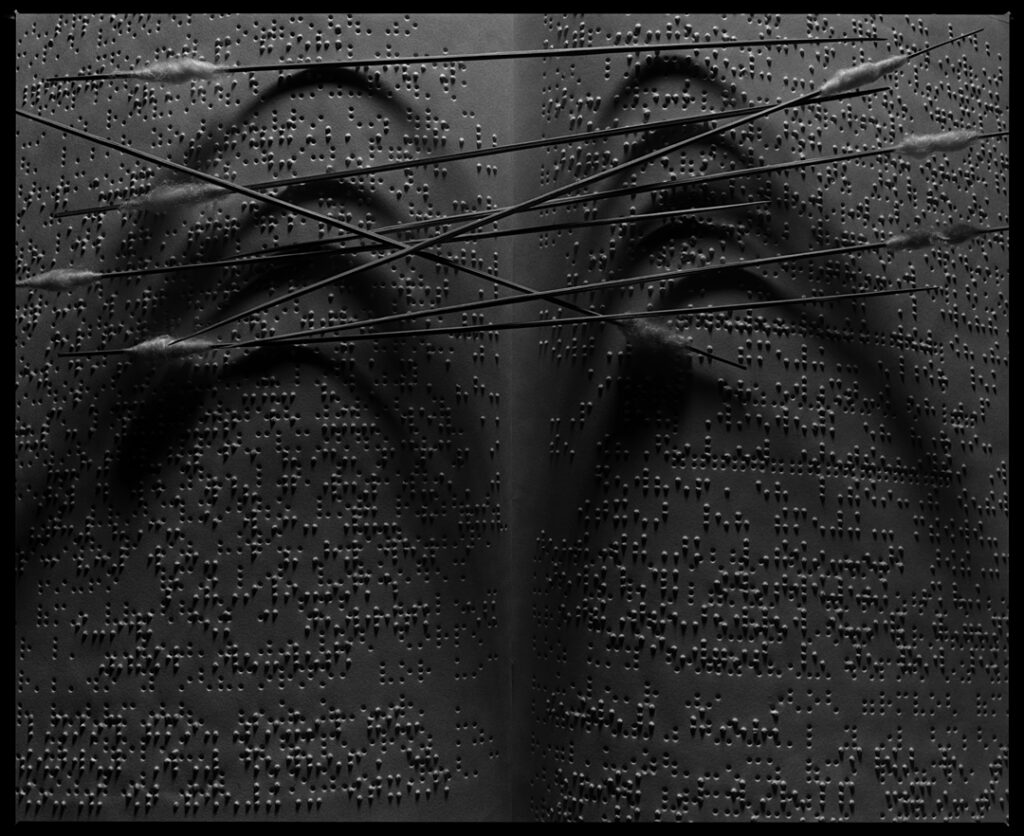
Darts II
1994 silver gelatin print 19 x 23 inches 48 x 58 cm
Museum voor Fotographie, Antwerpen, Belgium
Lehigh University Collection, Bethlehem, Pennsylvania
Written narrative about this piece
Our hearts were crushed in perfect unison as the doctor announced the results of our daughter’s tuberculosis test. My wife and I just looked at each other in disbelief while we blurted out a hundred questions. During the following weeks the three of us dreaded each trip to the hospital. Needles were stuck into my trusting child who was not even old enough to talk, nor understand why we were in support of her torture. Worse for me was having to gently lay her onto the metal table with the articulated x-ray device hovering above, knowing what was about to be sent through her tiny body. I felt helpless, so my only course of action was to create.
X-ray I is a mixture of elements which recur in many of my photographs: a hand, a musical instrument, and in this case, a small polaroid copy of my daughter’s chest x-ray.
Both Rib I and Rib II combine a rib, a symbol for my daughter’s condition, with South American religious symbols of suffering. Darts I, adds blow gun darts from the Amazon, piercing a woven belt from Peru.
In Darts II, blow gun darts are placed upon a book of Braille, with the lighting adjusted to make the shadow of the darts resemble a rib cage. Symbols in this and most of my images are metaphorical; the Braille implying helplessness combined with needle sharp blowgun darts. The Braille may also suggest the blindness of the doctors who had repeatedly administered the tests incorrectly on my daughter, as it turns out that my daughter had never been sick in the first place.
Wrapped ribs, depicts floating human ribs wrapped in strips of old cloth.

Framed Arrows
1994 hand colored silver gelatin print 19 x 23 inches, 48 x 58 cm
Maison Européenne de la Photographie, Paris, France

Gauntlets
1994 silver gelatin print 23 x 19 inches, 58 x 48 cm
The Royal Photographic Society, Bath, England
Written narrative about this piece
“Ayudame porfavor….”
He was sitting in the gutter right next to the curb where I was standing. I hadn’t noticed him because his dirty hair, skin, and clothes were camouflaged to the color of the Mexican dirt street.
“Help me… I’m stuck!” His manner of speech had a childlike innocence probably due to his provincial Spanish and Zapotec accent. I was musing about other things as he lifted up his hands to me. He wore heavy work gloves and I instinctively grabbed them, and tried to pull him to his feet. But there wasn’t the resistance nor weight that I had expected and he sailed high, as if he was a light -footed ballerina dancing with me. He laughed in an embarrassed sort of way. His legs were missing.
Shocked, I became aware of every detail in the immediate area. At his waist he wore a sock-like garment held together with pins and twine which covered the lower portion of his trunk. There was nothing below that. I lowered him back to his wheeled wooden platform.
I stooped down and lifted the front of his platform onto the curb, and my face came very close to his. All of the details of this man which previously had aroused a feeling of repulsion and disgust began to blur. It must have been due to the intensity of his face and his bright, penetrating eyes. He leaned forward to level himself against the extreme pitch of his platform as I lifted and pushed the back end onto the curb.
The task of getting him up onto the curb was over, and I asked, “Is there anything else I can do?” I expected him to ask for money, and momentarily his eyes retreated and lowered. Shyly he spoke, “My hands…they hurt.”
He held up both gloved hands in a gesture of a scrubbed surgeon trying to avoid touching anything, and he unveiled a gnarled, twisted, and crippled hand; the product of pounding the pavement to propel him on his platform. He took off the other glove to reveal the same horror.
His eyes calmed me, “My hands hurt and I can’t move my fingers very well….please move them, and crack the joints for me.” A wave of numbness engulfed me, while his eyes coaxed me and pleaded with me to lower my guard, to keep in check the fears of intimacy with fellow human beings.
He watched my face the whole time I worked on his hands. His eyes told me when I got in a good crack or when it was time to move onto another joint. Although we exchanged few words, our silent dialogue was lengthy and profound.
With considerable effort he was finally able to flex his hands. His face beaming, he thanked me and then zoomed down the sidewalk on his platform using the full stride of his arms. He stopped just before turning the corner. We waved to each other and then he was gone.
Stephen Althouse
Glove I
Glove II
Gauntlets
Silver Hands
Sacred Hand
Divino Maestro
X-ray I
Shrouded Gauntlet
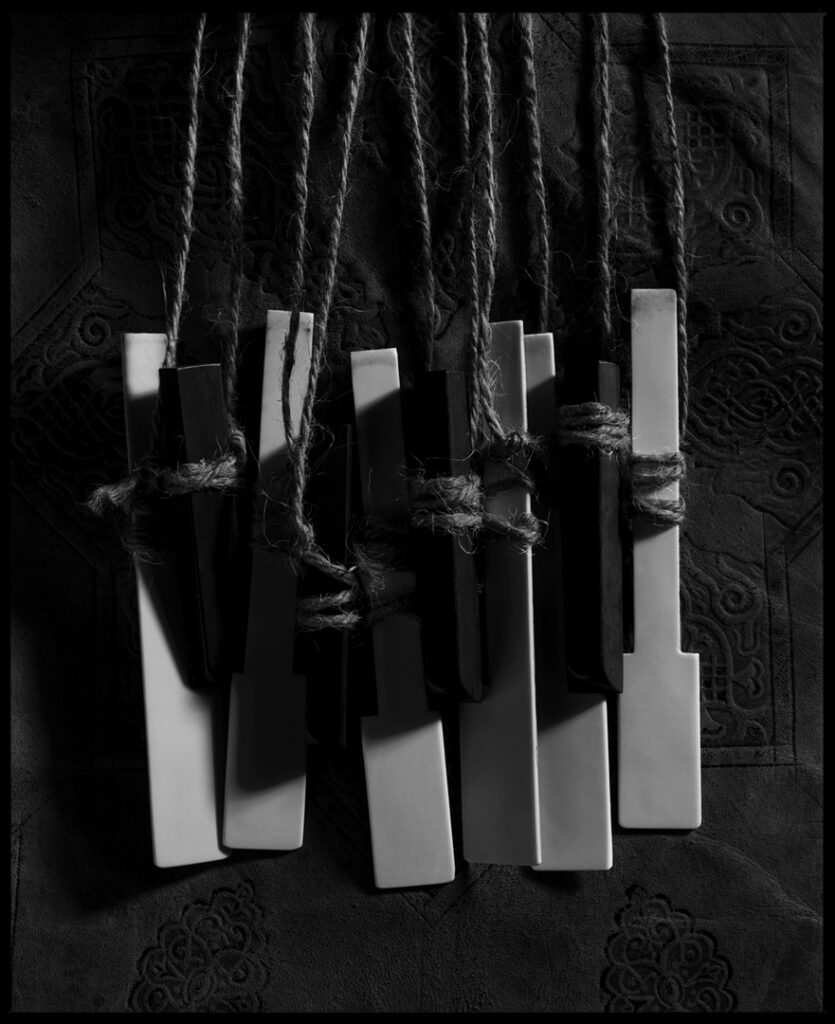
Keys
1994 silver gelatin print 21 x 19 inches, 53 x 48 cm
Museo Nacional de Bellas Artes, Buenos Aires, Argentina
Museum voor Fotographie, Antwerp, Belgium
Museum of Art, University of Michigan, Ann Arbor, Michigan
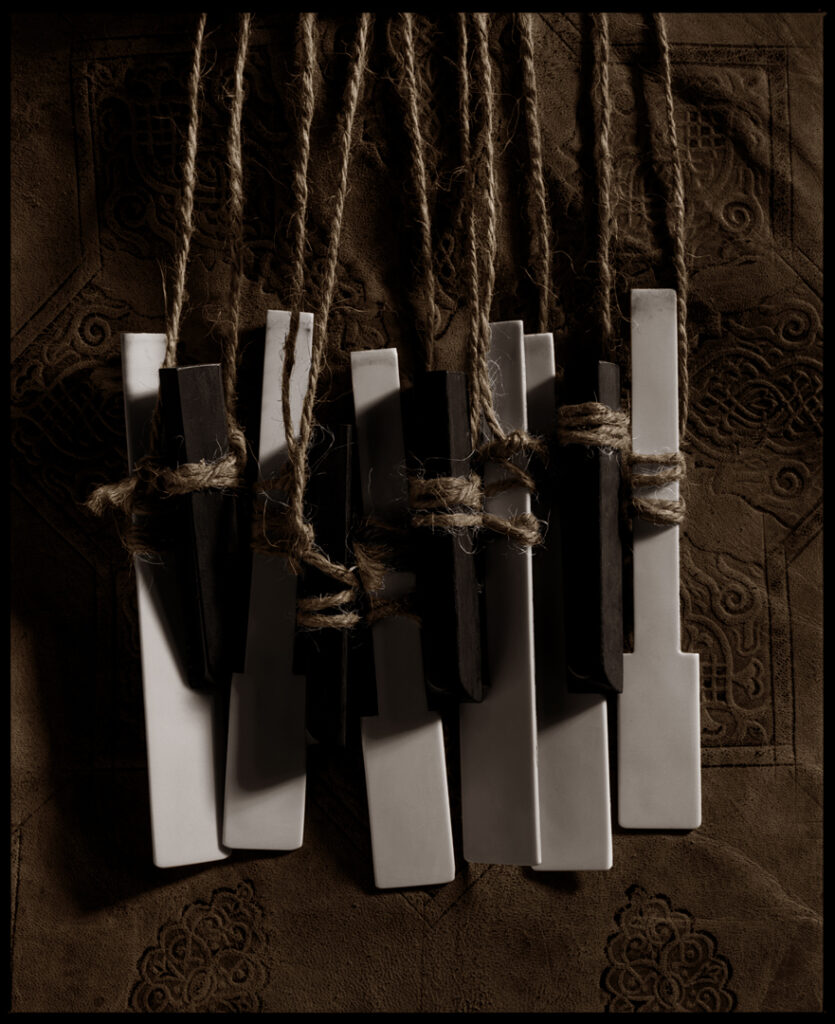
Keys (color)
1994 hand colored silver gelatin print 21 x 19 inches, 53 x 48 cm
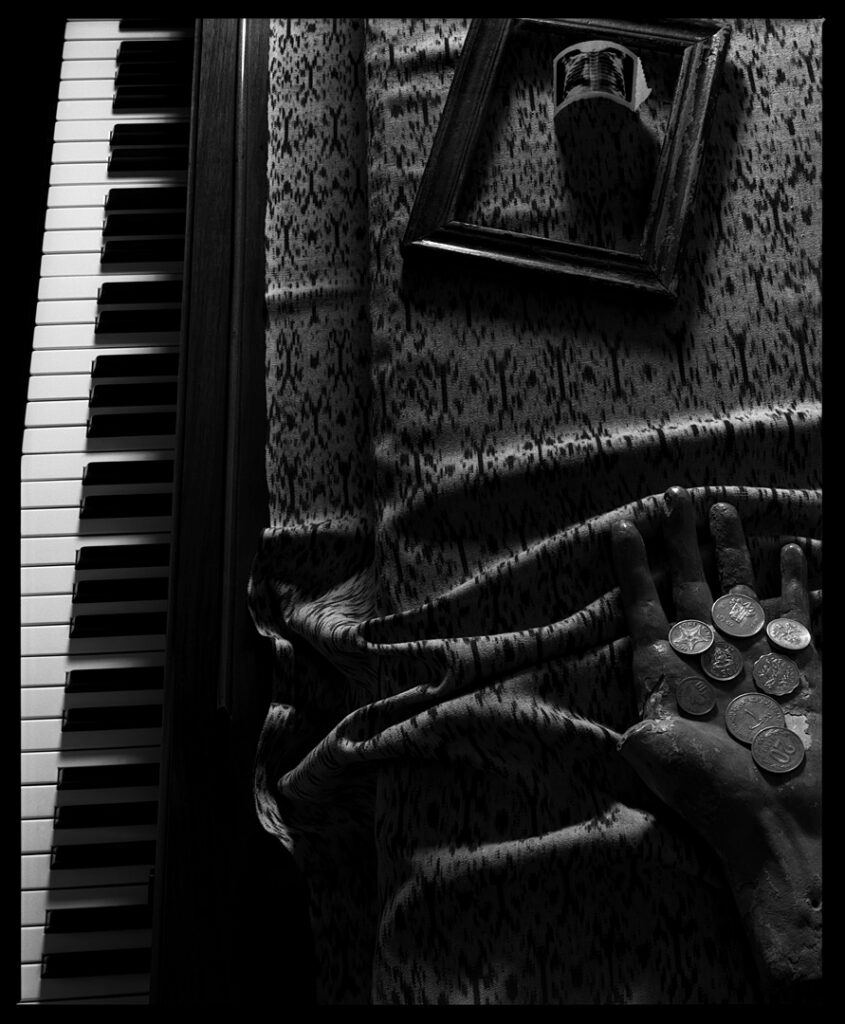
X ray I
1994 silver gelatin print 23 x 19 inches, 58 x 48 cm
Kunstmuseum Bonn, Germany
Written narrative about this piece
Our hearts were crushed in perfect unison as the doctor announced the results of our daughter’s tuberculosis test. My wife and I just looked at each other in disbelief while we blurted out a hundred questions. During the following weeks the three of us dreaded each trip to the hospital. Needles were stuck into my trusting child who was not even old enough to talk, nor understand why we were in support of her torture. Worse for me was having to gently lay her onto the metal table with the articulated x-ray device hovering above, knowing what was about to be sent through her tiny body. I felt helpless, so my only course of action was to create.
X-ray I is a mixture of elements which recur in many of my photographs: a hand, a musical instrument, and in this case, a small polaroid copy of my daughter’s chest x-ray.
Both Rib I and Rib II combine a rib, a symbol for my daughter’s condition, with South American religious symbols of suffering. Darts I, adds blow gun darts from the Amazon, piercing a woven belt from Peru.
In Darts II, blow gun darts are placed upon a book of Braille, with the lighting adjusted to make the shadow of the darts resemble a rib cage. Symbols in this and most of my images are metaphorical; the Braille implying helplessness combined with needle sharp blowgun darts. The Braille may also suggest the blindness of the doctors who had repeatedly administered the tests incorrectly on my daughter, as it turns out that my daughter had never been sick in the first place.
Wrapped ribs, depicts floating human ribs wrapped in strips of old cloth.
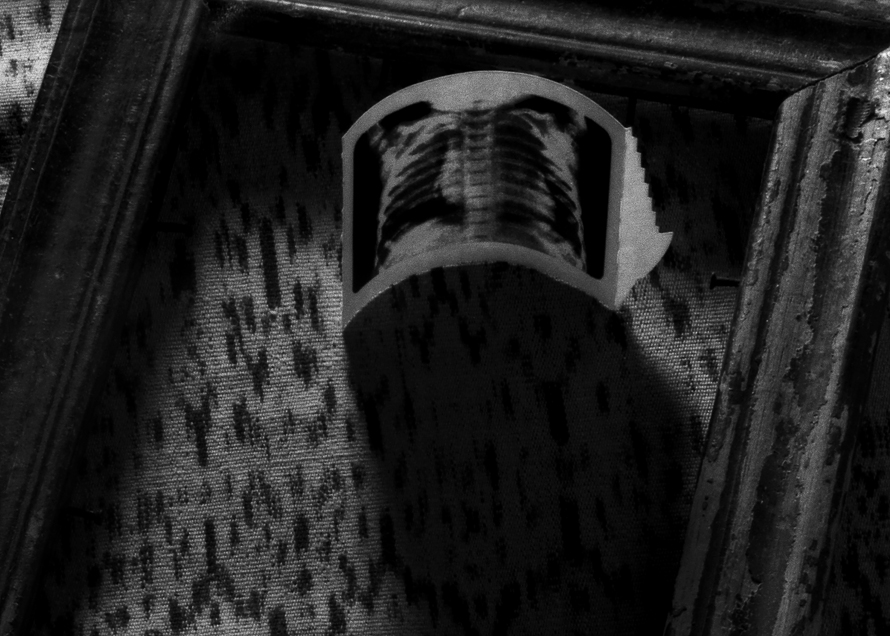
detail a – X ray I

detail b – X ray I
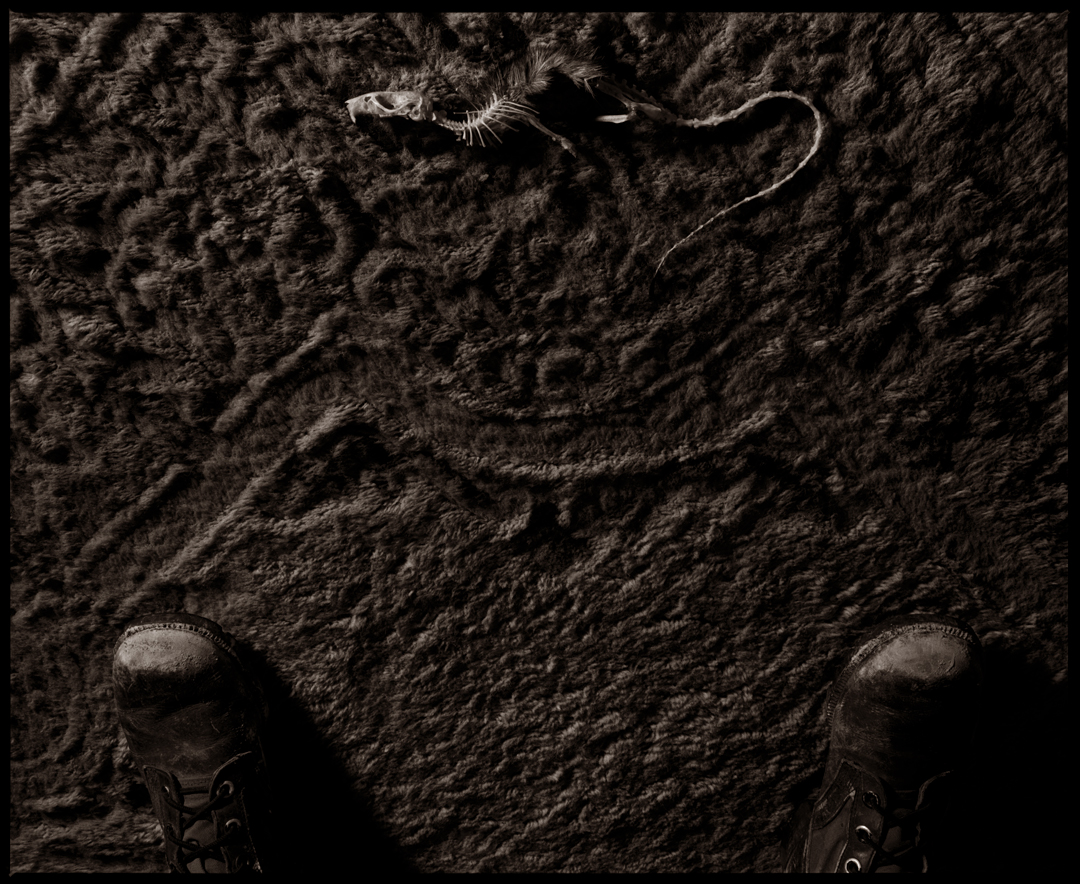
Bootweight II
1993 sepia toned silver gelatin print 19 x 23 inches, 48 x 58 cm
Museum of Art, University of Michigan, Ann Arbor, Michigan

Golden Tadpoles
1993 hand colored silver gelatin print 23 x 19 inches, 58 x 48 cm
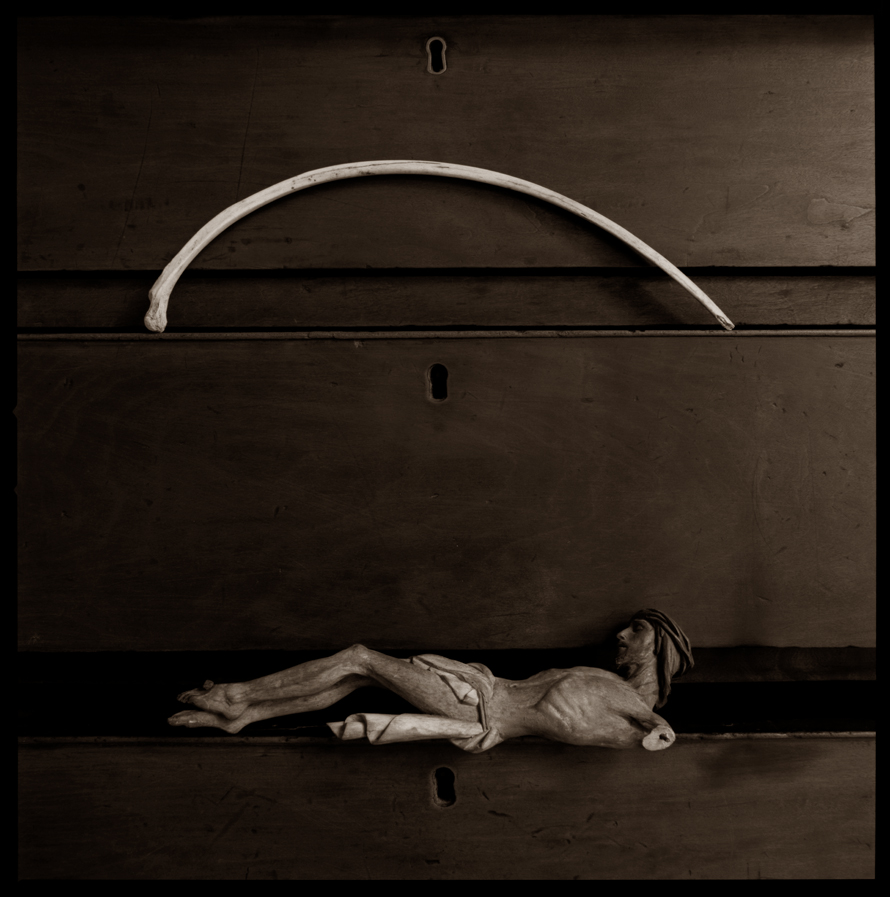
Rib I
1993 sepia toned silver gelatin print 19 x 19 inches, 48 x 48 cm
Museum für Gestaltung Zürich, Zürich, Switzerland
Written narrative about this piece
Our hearts were crushed in perfect unison as the doctor announced the results of our daughter’s tuberculosis test. My wife and I just looked at each other in disbelief while we blurted out a hundred questions. During the following weeks the three of us dreaded each trip to the hospital. Needles were stuck into my trusting child who was not even old enough to talk, nor understand why we were in support of her torture. Worse for me was having to gently lay her onto the metal table with the articulated x-ray device hovering above, knowing what was about to be sent through her tiny body. I felt helpless, so my only course of action was to create.
X-ray I is a mixture of elements which recur in many of my photographs: a hand, a musical instrument, and in this case, a small polaroid copy of my daughter’s chest x-ray.
Both Rib I and Rib II combine a rib, a symbol for my daughter’s condition, with South American religious symbols of suffering. Darts I, adds blow gun darts from the Amazon, piercing a woven belt from Peru.
In Darts II, blow gun darts are placed upon a book of Braille, with the lighting adjusted to make the shadow of the darts resemble a rib cage. Symbols in this and most of my images are metaphorical; the Braille implying helplessness combined with needle sharp blowgun darts. The Braille may also suggest the blindness of the doctors who had repeatedly administered the tests incorrectly on my daughter, as it turns out that my daughter had never been sick in the first place.
Wrapped ribs, depicts floating human ribs wrapped in strips of old cloth.
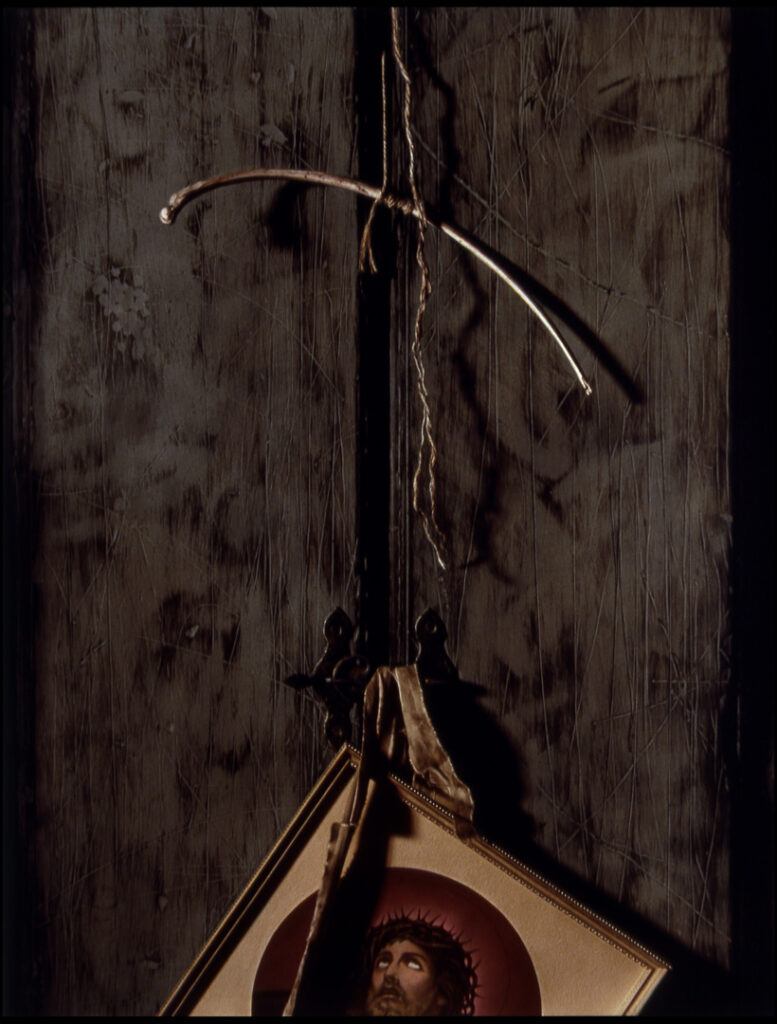
Rib II
1993 hand colored silver gelatin print 19 x 15 inches, 48 x 38 cm
Maison Européenne de la Photographie, Paris, France
Written narrative about this piece
Our hearts were crushed in perfect unison as the doctor announced the results of our daughter’s tuberculosis test. My wife and I just looked at each other in disbelief while we blurted out a hundred questions. During the following weeks the three of us dreaded each trip to the hospital. Needles were stuck into my trusting child who was not even old enough to talk, nor understand why we were in support of her torture. Worse for me was having to gently lay her onto the metal table with the articulated x-ray device hovering above, knowing what was about to be sent through her tiny body. I felt helpless, so my only course of action was to create.
X-ray I is a mixture of elements which recur in many of my photographs: a hand, a musical instrument, and in this case, a small polaroid copy of my daughter’s chest x-ray.
Both Rib I and Rib II combine a rib, a symbol for my daughter’s condition, with South American religious symbols of suffering. Darts I, adds blow gun darts from the Amazon, piercing a woven belt from Peru.
In Darts II, blow gun darts are placed upon a book of Braille, with the lighting adjusted to make the shadow of the darts resemble a rib cage. Symbols in this and most of my images are metaphorical; the Braille implying helplessness combined with needle sharp blowgun darts. The Braille may also suggest the blindness of the doctors who had repeatedly administered the tests incorrectly on my daughter, as it turns out that my daughter had never been sick in the first place.
Wrapped ribs, depicts floating human ribs wrapped in strips of old cloth.
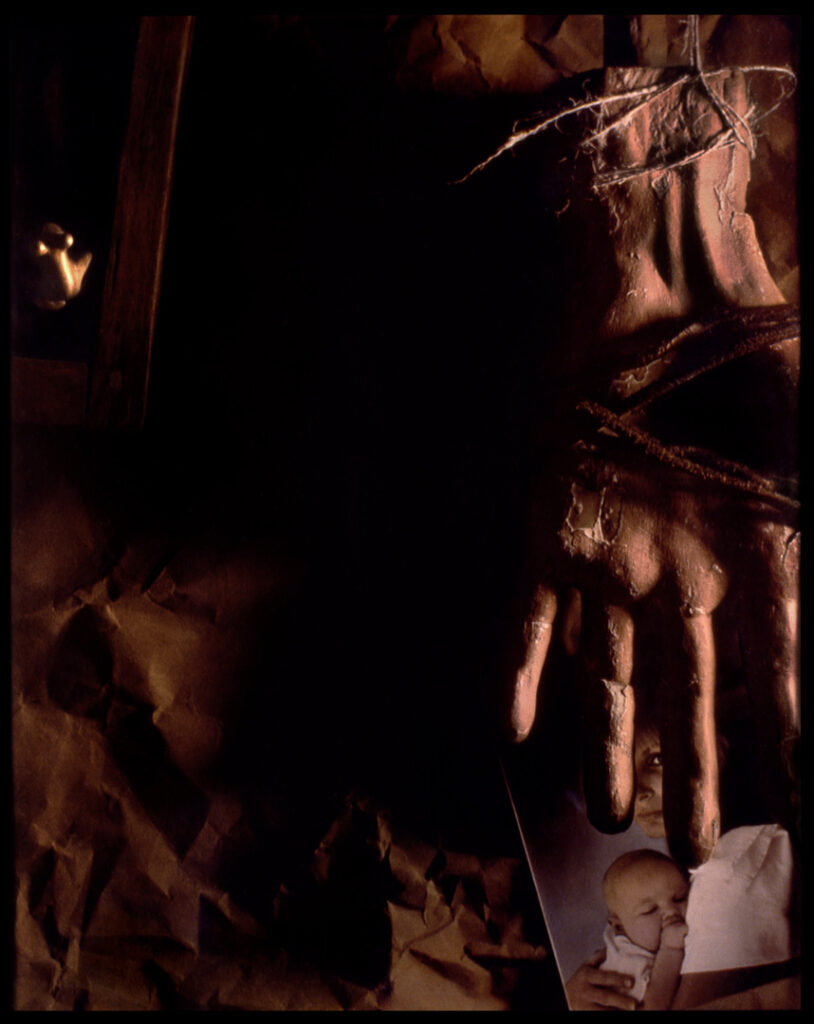
Sacred Hand
1993 hand colored silver gelatin print 19 x 19 inches, 48 x 48 cm
Münchner Stadtmuseum – Fotomuseum, Munich, Germany
Written narrative about this piece
“Ayudame porfavor….”
He was sitting in the gutter right next to the curb where I was standing. I hadn’t noticed him because his dirty hair, skin, and clothes were camouflaged to the color of the Mexican dirt street.
“Help me… I’m stuck!” His manner of speech had a childlike innocence probably due to his provincial Spanish and Zapotec accent. I was musing about other things as he lifted up his hands to me. He wore heavy work gloves and I instinctively grabbed them, and tried to pull him to his feet. But there wasn’t the resistance nor weight that I had expected and he sailed high, as if he was a light -footed ballerina dancing with me. He laughed in an embarrassed sort of way. His legs were missing.
Shocked, I became aware of every detail in the immediate area. At his waist he wore a sock-like garment held together with pins and twine which covered the lower portion of his trunk. There was nothing below that. I lowered him back to his wheeled wooden platform.
I stooped down and lifted the front of his platform onto the curb, and my face came very close to his. All of the details of this man which previously had aroused a feeling of repulsion and disgust began to blur. It must have been due to the intensity of his face and his bright, penetrating eyes. He leaned forward to level himself against the extreme pitch of his platform as I lifted and pushed the back end onto the curb.
The task of getting him up onto the curb was over, and I asked, “Is there anything else I can do?” I expected him to ask for money, and momentarily his eyes retreated and lowered. Shyly he spoke, “My hands…they hurt.”
He held up both gloved hands in a gesture of a scrubbed surgeon trying to avoid touching anything, and he unveiled a gnarled, twisted, and crippled hand; the product of pounding the pavement to propel him on his platform. He took off the other glove to reveal the same horror.
His eyes calmed me, “My hands hurt and I can’t move my fingers very well….please move them, and crack the joints for me.” A wave of numbness engulfed me, while his eyes coaxed me and pleaded with me to lower my guard, to keep in check the fears of intimacy with fellow human beings.
He watched my face the whole time I worked on his hands. His eyes told me when I got in a good crack or when it was time to move onto another joint. Although we exchanged few words, our silent dialogue was lengthy and profound.
With considerable effort he was finally able to flex his hands. His face beaming, he thanked me and then zoomed down the sidewalk on his platform using the full stride of his arms. He stopped just before turning the corner. We waved to each other and then he was gone.
Stephen Althouse
Glove I
Glove II
Gauntlets
Silver Hands
Sacred Hand
Divino Maestro
X-ray I
Shrouded Gauntlet
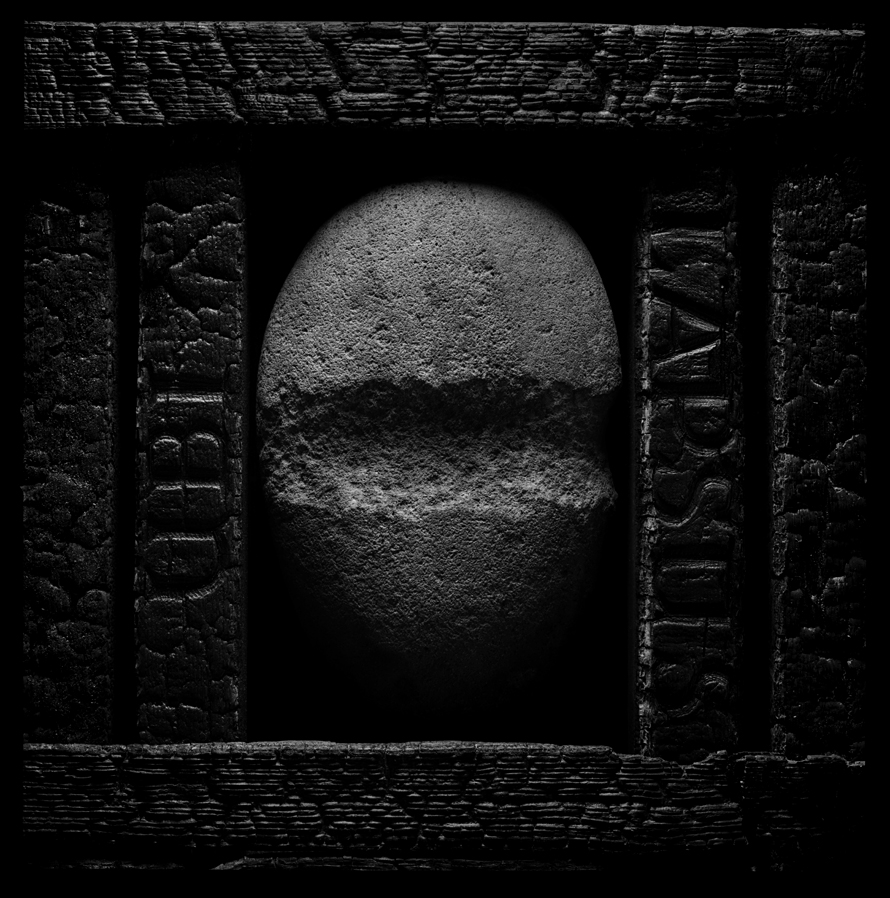
Ubi Lapsus
1993 silver gelatin print 23 x 23 inches, 59 x 59 cm
Stedelijk Museum, Amsterdam, Netherlands
Museum Moderner Kunst, Vienna, Austria
Museo Nacional de Bellas Artes, Buenos Aires, Argentina
Centre d’Art et de Culture Georges-Pompidou, Paris, France
Written narrative about this piece
To:
Hripsimé Visser, Curator of Photography
Stedelijk Museum
Paulus Potterstraat 13
1071 CX Amsterdam, Nederlands
Requested information regarding Ubi Lapsus:
Across the stream I spotted something that vaguely resembled an adolescent boy’s dream treasure. I instinctively leaped towards it; all the while my young imagination was filling in the hidden details. During those few seconds needed to get to it I was already feeling the glory, commendations and elevated stature I was to receive among my fellow boy scouts back at the campsite. It appeared to be an native American stone ax head; the rarest find ever. But to my disappointment it was only a rounded creek stone, and as I gazed at the stone while turning it over and over in my small hands I had an idea.
Before anyone else returned, I bee-lined it back to the campsite and began chipping away at the stone with a steel tent peg and a hammer. As I was finishing its dirt and ash patina, scouts began trickling back to camp tired and empty handed from the traditional weekend search for Native American stone arrowheads. Everyone was in total awe of my “find”, and its authenticity was never doubted. After all we were boy scouts pledged to an oath of honesty and honor, and under different circumstances my craftsmanship would have earned me a merit badge. Gradually though I felt the attention becoming excessive. It was especially hard watching the adult leaders reverently studying my ax head as if it was a sacred relic or an important anthropological discovery. It became too late to pass it off as a joke, and that weekend was filled with the thrill of discovery and adventure for everyone but me. Mine was empty except for a dull knotted up feeling in my stomach as I pretended to share the excitement of my fellow campers.
Over time I gradually forgot about the incident, and the ax head found its way into my family’s magnificent old stone barn. It seemed that everything of significance in my life eventually got stored in the barn. I had accumulated an enormous chronologically stratified mass which included toys, comic books, saddles, riding boots, motorcycle parts, electric guitars, as well as my paintings, sculptures, and photographs. In another room was an even larger quantity of my parent’s family heirlooms and antique furniture.
A few winters ago my mother left the cold north and came to visit with me, my wife and daughter in Miami. The telephone rang, and she answered the long distance call from Pennsylvania. She screamed, “The barn is burning!” Over a thousand miles away, and there was nothing we could do but cry. She and I took the next available flight north and then we rented a car. Finally as we drove down the dirt lane we could see the dark ruins silhouetted against the cold gray sky, standing in the bareness of the winter fields. All that remained were three scorched stone walls and jumbled charred timbers, all being lightly dusted by swirling snowflakes. For two days I sadly poked around in the thick ashes with a metal rod, mourning the barn and hoping to find something which could have survived the inferno. Little by little I accumulated a handful of identifiable blackened and burned trinkets. Then I hit something hard and larger than before, and excitedly I dug down wondering what I had found. It was amazing that after more than thirty-five years, the same wave of guilt and queasiness overcame me the moment I laid eyes upon the stone ax head.
Upon returning to Miami, I constructed a wooden box for the ax head and carved UBI LAPSUS (Latin: where have I fallen) into the wood. I set the assemblage on fire, and watched as it slowly burned itself out. Using the charred remains I made the photograph Ubi Lapsus.
Stephen Althouse July 24,1997
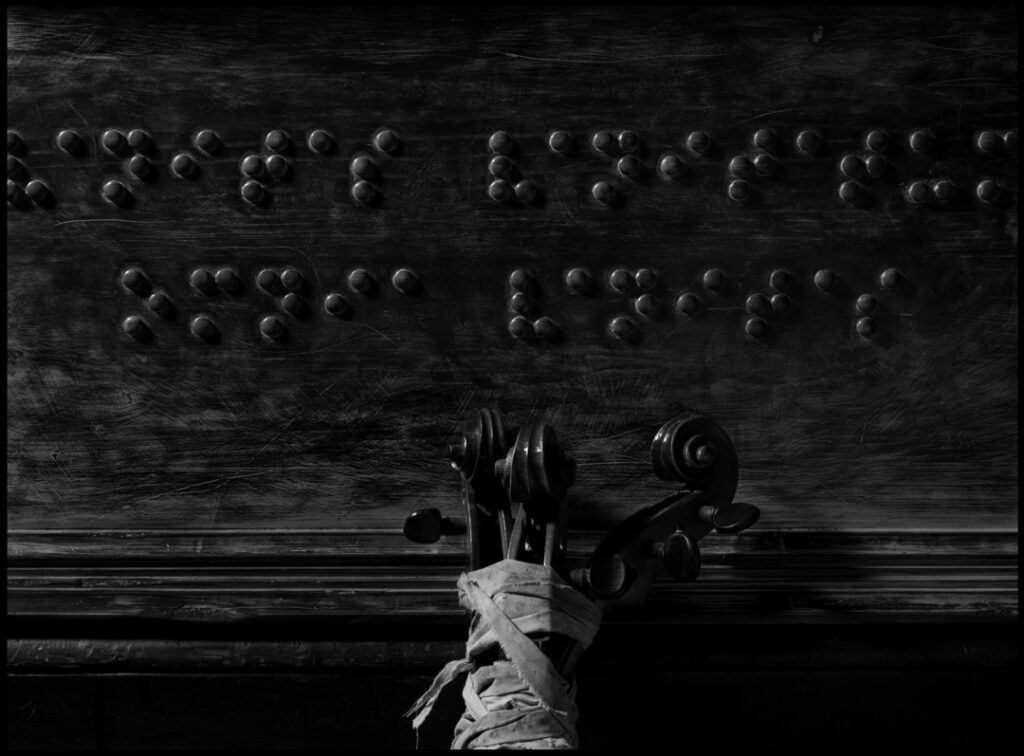
Vanitas (Violin III)
1993 silver gelatin print 10 x 13 inches, 25 x 33 cm
Bayerische Staatgemäldesammlungen, Neue Pinakothek, Munich, Germay
Museo de la Real Academia de Bellas Artes de San Fernando, Madrid, Spain
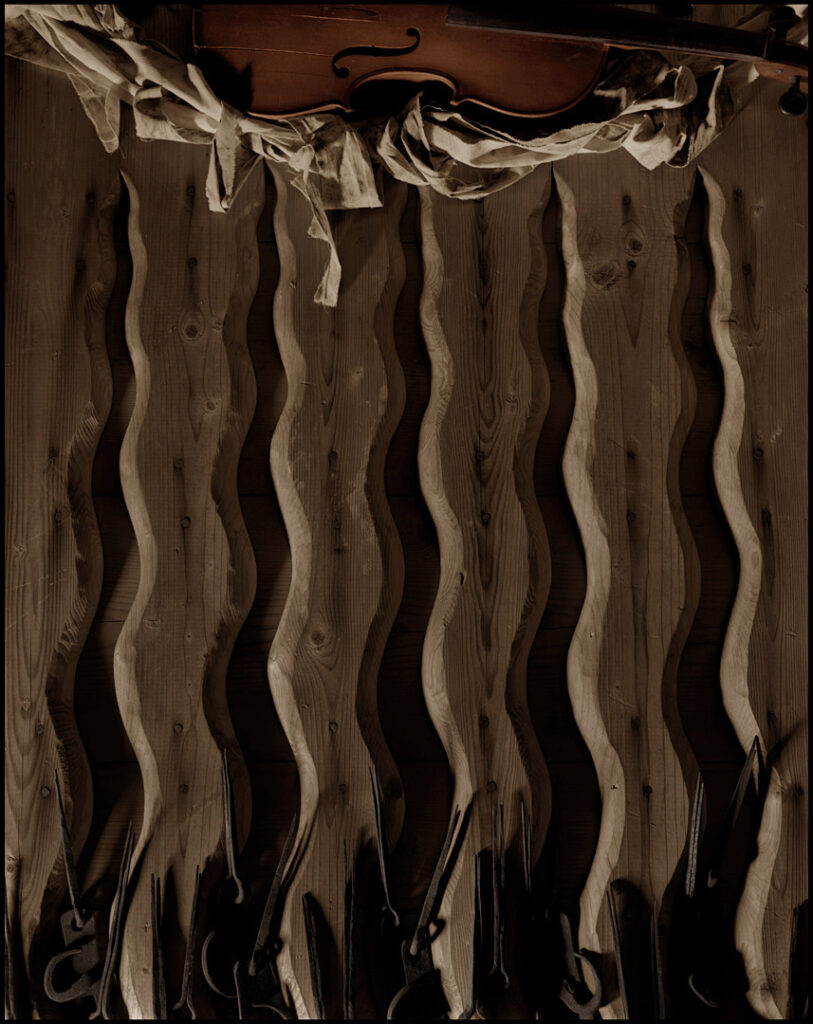
Violin II
1992 hand colored silver gelatin print 23 x 19 inches, 58 x 48 cm
Broad Art Museum, East Lansing, Michigan

Violin I
1991 silver gelatin print 23 x 19 inches, 58 x 48 cm
Galerie der Stadt Stuttgart, Germany
Flint Institute of Arts, Flint, Michigan
Vero Beach Museum of Art, Vero Beach, Florida
Museo de Arte, Lima, Perú
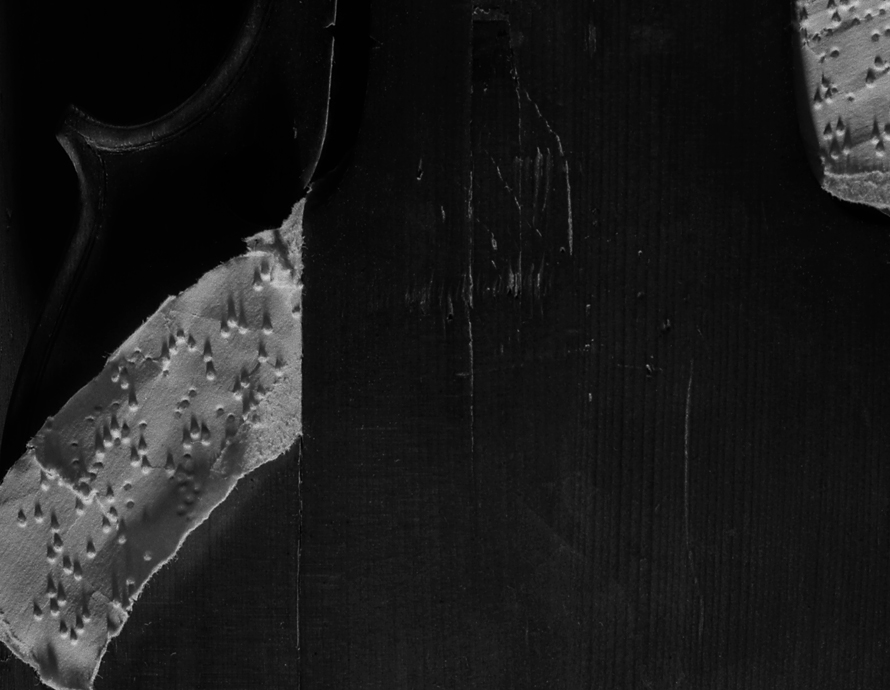
detail – Violin I
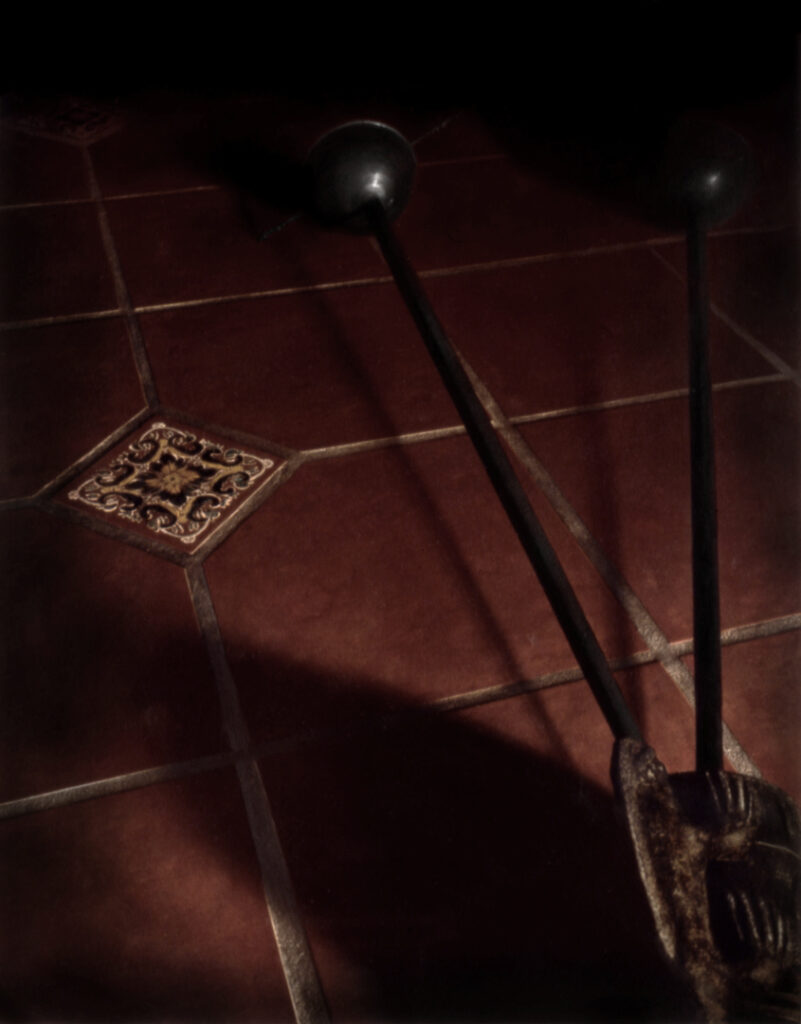
Blades II
1989 hand colored silver gelatin print 23 x 19 inches, 58 x 48 cm

Darts I
1989 hand colored silver gelatin print 23 x 19 inches, 58 x 48 cm
Written narrative about this piece
We’ve been best friends since elementary school always seeking adventures, sometimes even unpleasant ones just to see if we could joke our way through them. We did hard labor on the railroad, played in a rock and roll band in the ’60s, and rode motorcycles, to name a few. Laughter had added magic to everything for us….but we choked on our laughter when his wife died in his arms.
Goodbye I is a photograph of my living room rug. The original colors of the rug are lost with the use of black and white film, and this combined with sepia toner give the foreground a sand-like quality. I chopped some large tropical foliage from my yard and placed them on the rug, and hidden in the shadows of the leaves is a Mayan head with goodbye in Braille streaming from one eye. Two small turtles walk slowly across the “landscape”.
Goodbye II was created while I contemplated love, the near loss of love, and the emptiness of losing one’s love. I placed the same Mayan head that I used in Goodbye I into some sand which I imprinted with my hands and fingers. On the Mexican machete blade I had etched in Zapotec dialect a vow of love to my wife who almost died of typhoid fever in that region of Mexico prior to my friend’s terrible loss.
Adulthood was forced upon us with the death of my friend’s wife, even though we had been resisting for forty years. In Angels Die Hard II I feel like I’m saying goodbye to my carefree youth. Similar in composition and style of some old Mexican religious paintings, my old decaying leather motorcycle jacket seems to be ascending upon a palm leaf.
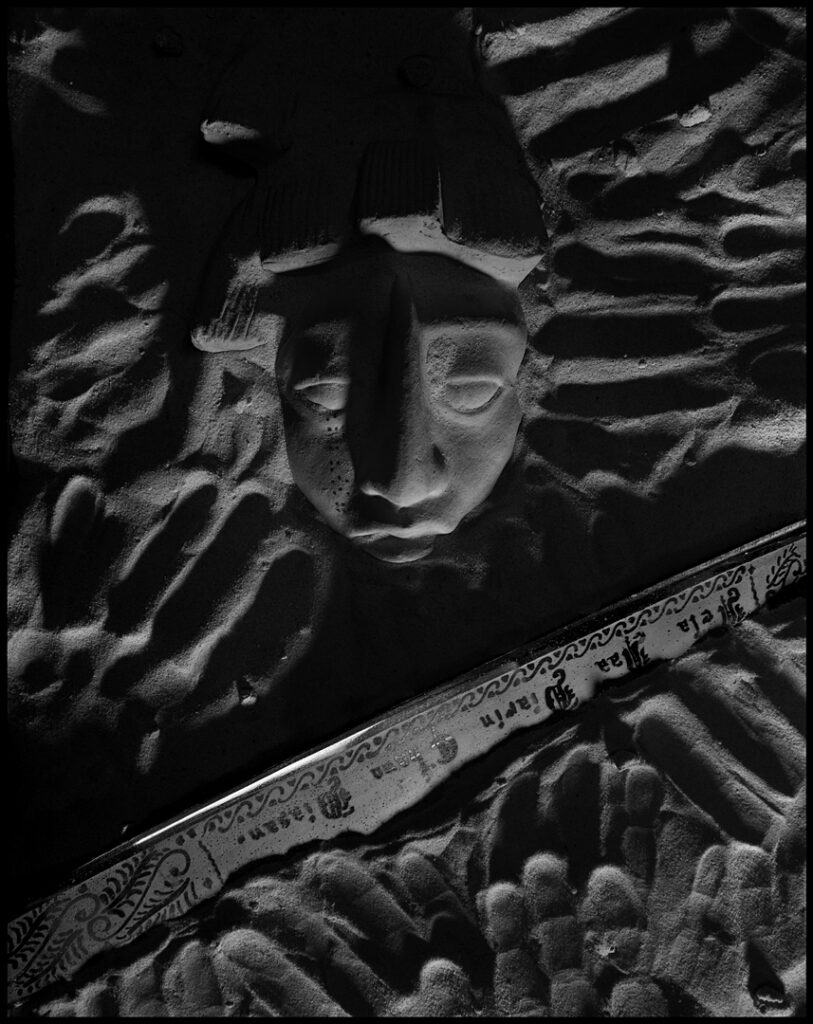
Goodbye II
1988 silver gelatin print 19 x 15 inches, 48 x 38 cm
Museum Moderner Kunst, Vienna, Austria
Museum of Fine Arts, St. Petersburg, Florida
Flint Institute of Arts, Flint, Michigan
Dorsky Museum of Art, CPW Collection, New Paltz, New York
Written narrative about this piece
We’ve been best friends since elementary school always seeking adventures, sometimes even unpleasant ones just to see if we could joke our way through them. We did hard labor on the railroad, played in a rock and roll band in the ’60s, and rode motorcycles, to name a few. Laughter had added magic to everything for us….but we choked on our laughter when his wife died in his arms.
Goodbye I is a photograph of my living room rug. The original colors of the rug are lost with the use of black and white film, and this combined with sepia toner give the foreground a sand-like quality. I chopped some large tropical foliage from my yard and placed them on the rug, and hidden in the shadows of the leaves is a Mayan head with goodbye in Braille streaming from one eye. Two small turtles walk slowly across the “landscape”.
Goodbye II was created while I contemplated love, the near loss of love, and the emptiness of losing one’s love. I placed the same Mayan head that I used in Goodbye I into some sand which I imprinted with my hands and fingers. On the Mexican machete blade I had etched in Zapotec dialect a vow of love to my wife who almost died of typhoid fever in that region of Mexico prior to my friend’s terrible loss.
Adulthood was forced upon us with the death of my friend’s wife, even though we had been resisting for forty years. In Angels Die Hard II I feel like I’m saying goodbye to my carefree youth. Similar in composition and style of some old Mexican religious paintings, my old decaying leather motorcycle jacket seems to be ascending upon a palm leaf.

Glove I
1987 silver gelatin print 19 x 15 inches, 48 x 38 cm
Lentos Kunstmuseum Linz, Austria
Museum of Art, Boston, Massachusetts
Written narrative about this piece
“Ayudame porfavor….”
He was sitting in the gutter right next to the curb where I was standing. I hadn’t noticed him because his dirty hair, skin, and clothes were camouflaged to the color of the Mexican dirt street.
“Help me… I’m stuck!” His manner of speech had a childlike innocence probably due to his provincial Spanish and Zapotec accent. I was musing about other things as he lifted up his hands to me. He wore heavy work gloves and I instinctively grabbed them, and tried to pull him to his feet. But there wasn’t the resistance nor weight that I had expected and he sailed high, as if he was a light -footed ballerina dancing with me. He laughed in an embarrassed sort of way. His legs were missing.
Shocked, I became aware of every detail in the immediate area. At his waist he wore a sock-like garment held together with pins and twine which covered the lower portion of his trunk. There was nothing below that. I lowered him back to his wheeled wooden platform.
I stooped down and lifted the front of his platform onto the curb, and my face came very close to his. All of the details of this man which previously had aroused a feeling of repulsion and disgust began to blur. It must have been due to the intensity of his face and his bright, penetrating eyes. He leaned forward to level himself against the extreme pitch of his platform as I lifted and pushed the back end onto the curb.
The task of getting him up onto the curb was over, and I asked, “Is there anything else I can do?” I expected him to ask for money, and momentarily his eyes retreated and lowered. Shyly he spoke, “My hands…they hurt.”
He held up both gloved hands in a gesture of a scrubbed surgeon trying to avoid touching anything, and he unveiled a gnarled, twisted, and crippled hand; the product of pounding the pavement to propel him on his platform. He took off the other glove to reveal the same horror.
His eyes calmed me, “My hands hurt and I can’t move my fingers very well….please move them, and crack the joints for me.” A wave of numbness engulfed me, while his eyes coaxed me and pleaded with me to lower my guard, to keep in check the fears of intimacy with fellow human beings.
He watched my face the whole time I worked on his hands. His eyes told me when I got in a good crack or when it was time to move onto another joint. Although we exchanged few words, our silent dialogue was lengthy and profound.
With considerable effort he was finally able to flex his hands. His face beaming, he thanked me and then zoomed down the sidewalk on his platform using the full stride of his arms. He stopped just before turning the corner. We waved to each other and then he was gone.
Stephen Althouse
Glove I
Glove II
Gauntlets
Silver Hands
Sacred Hand
Divino Maestro
X-ray I
Shrouded Gauntlet
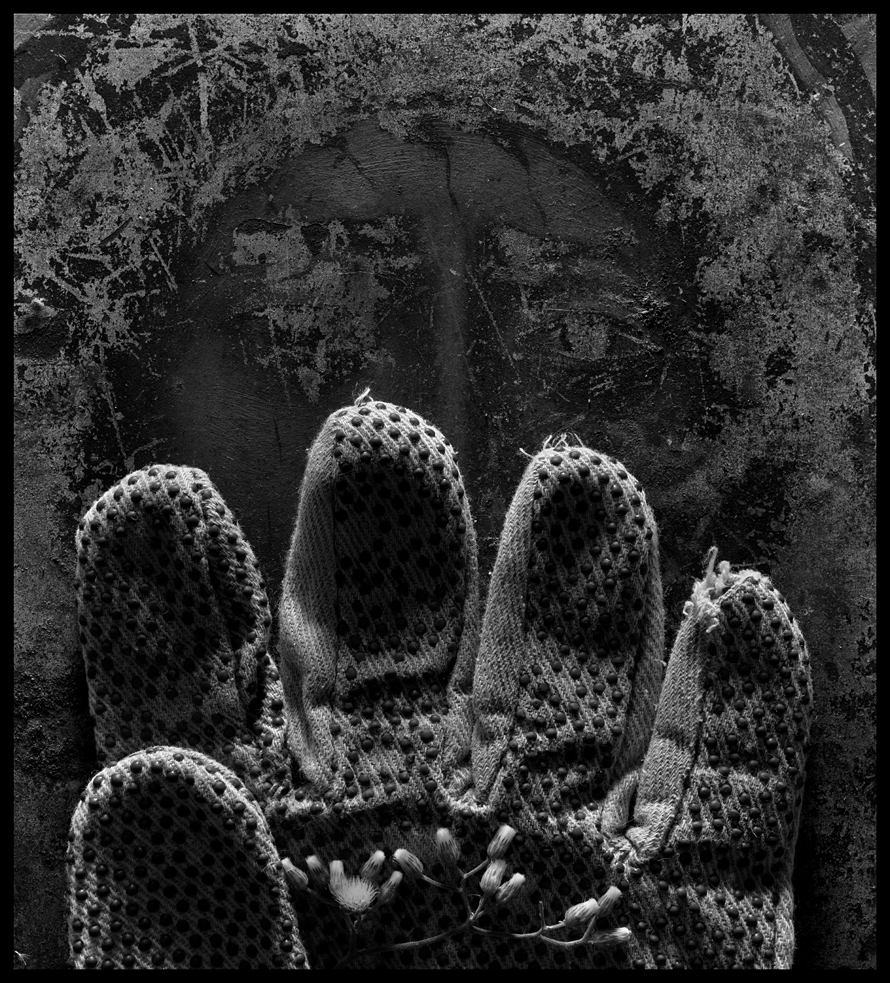
Glove II
1987 silver gelatin print 23 x 19 inches, 58 x 48 cm
Museo de Arte Contemporáneo – Museo de Santa Cruz, Toledo, Spain
Museo de Arte Contemporáneo, Bogota, Colombia
Lehigh University Collection, Bethlehem, Pennsylvania
Written narrative about this piece
“Ayudame porfavor….”
He was sitting in the gutter right next to the curb where I was standing. I hadn’t noticed him because his dirty hair, skin, and clothes were camouflaged to the color of the Mexican dirt street.
“Help me… I’m stuck!” His manner of speech had a childlike innocence probably due to his provincial Spanish and Zapotec accent. I was musing about other things as he lifted up his hands to me. He wore heavy work gloves and I instinctively grabbed them, and tried to pull him to his feet. But there wasn’t the resistance nor weight that I had expected and he sailed high, as if he was a light -footed ballerina dancing with me. He laughed in an embarrassed sort of way. His legs were missing.
Shocked, I became aware of every detail in the immediate area. At his waist he wore a sock-like garment held together with pins and twine which covered the lower portion of his trunk. There was nothing below that. I lowered him back to his wheeled wooden platform.
I stooped down and lifted the front of his platform onto the curb, and my face came very close to his. All of the details of this man which previously had aroused a feeling of repulsion and disgust began to blur. It must have been due to the intensity of his face and his bright, penetrating eyes. He leaned forward to level himself against the extreme pitch of his platform as I lifted and pushed the back end onto the curb.
The task of getting him up onto the curb was over, and I asked, “Is there anything else I can do?” I expected him to ask for money, and momentarily his eyes retreated and lowered. Shyly he spoke, “My hands…they hurt.”
He held up both gloved hands in a gesture of a scrubbed surgeon trying to avoid touching anything, and he unveiled a gnarled, twisted, and crippled hand; the product of pounding the pavement to propel him on his platform. He took off the other glove to reveal the same horror.
His eyes calmed me, “My hands hurt and I can’t move my fingers very well….please move them, and crack the joints for me.” A wave of numbness engulfed me, while his eyes coaxed me and pleaded with me to lower my guard, to keep in check the fears of intimacy with fellow human beings.
He watched my face the whole time I worked on his hands. His eyes told me when I got in a good crack or when it was time to move onto another joint. Although we exchanged few words, our silent dialogue was lengthy and profound.
With considerable effort he was finally able to flex his hands. His face beaming, he thanked me and then zoomed down the sidewalk on his platform using the full stride of his arms. He stopped just before turning the corner. We waved to each other and then he was gone.
Stephen Althouse
Glove I
Glove II
Gauntlets
Silver Hands
Sacred Hand
Divino Maestro
X-ray I
Shrouded Gauntlet
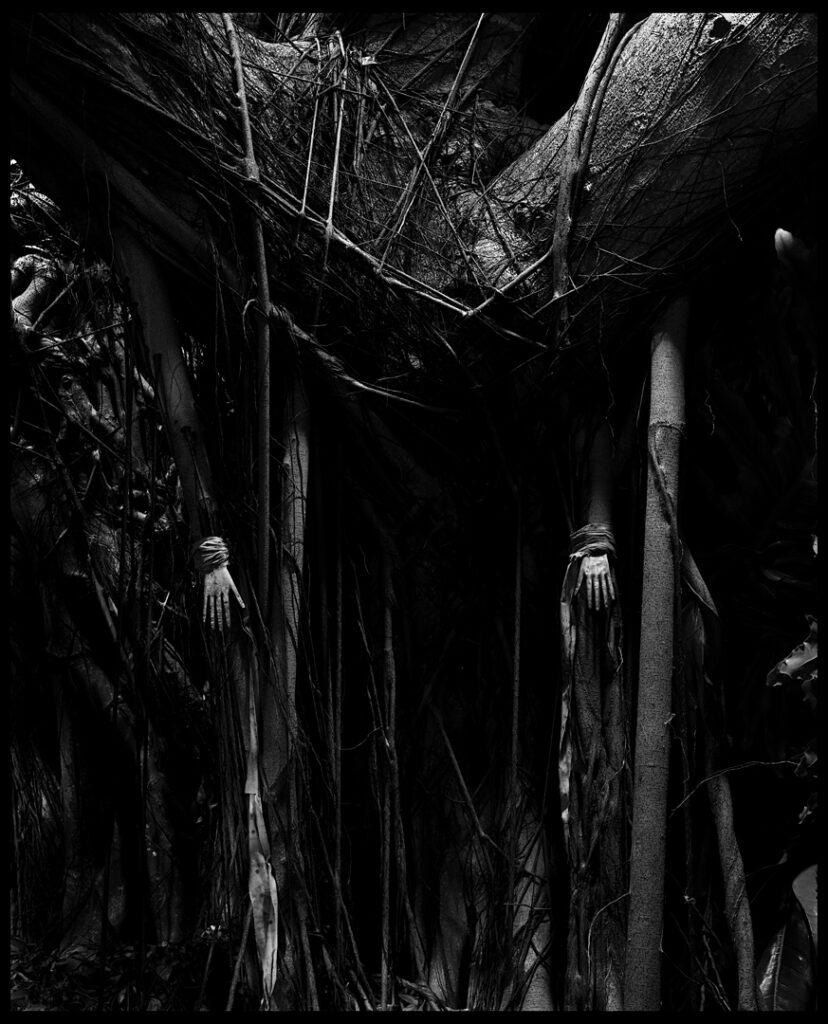
Silver Hands
1987 silver gelatin print 19 x 15 inches, 48 x 38 cm
Fogg Museum, Cambridge, Massachusetts
Boca Raton Museum of Art, Boca Raton, Florida
New York University Collection. – Tische School of Art, New York, New York
Written narrative about this piece
“Ayudame porfavor….”
He was sitting in the gutter right next to the curb where I was standing. I hadn’t noticed him because his dirty hair, skin, and clothes were camouflaged to the color of the Mexican dirt street.
“Help me… I’m stuck!” His manner of speech had a childlike innocence probably due to his provincial Spanish and Zapotec accent. I was musing about other things as he lifted up his hands to me. He wore heavy work gloves and I instinctively grabbed them, and tried to pull him to his feet. But there wasn’t the resistance nor weight that I had expected and he sailed high, as if he was a light -footed ballerina dancing with me. He laughed in an embarrassed sort of way. His legs were missing.
Shocked, I became aware of every detail in the immediate area. At his waist he wore a sock-like garment held together with pins and twine which covered the lower portion of his trunk. There was nothing below that. I lowered him back to his wheeled wooden platform.
I stooped down and lifted the front of his platform onto the curb, and my face came very close to his. All of the details of this man which previously had aroused a feeling of repulsion and disgust began to blur. It must have been due to the intensity of his face and his bright, penetrating eyes. He leaned forward to level himself against the extreme pitch of his platform as I lifted and pushed the back end onto the curb.
The task of getting him up onto the curb was over, and I asked, “Is there anything else I can do?” I expected him to ask for money, and momentarily his eyes retreated and lowered. Shyly he spoke, “My hands…they hurt.”
He held up both gloved hands in a gesture of a scrubbed surgeon trying to avoid touching anything, and he unveiled a gnarled, twisted, and crippled hand; the product of pounding the pavement to propel him on his platform. He took off the other glove to reveal the same horror.
His eyes calmed me, “My hands hurt and I can’t move my fingers very well….please move them, and crack the joints for me.” A wave of numbness engulfed me, while his eyes coaxed me and pleaded with me to lower my guard, to keep in check the fears of intimacy with fellow human beings.
He watched my face the whole time I worked on his hands. His eyes told me when I got in a good crack or when it was time to move onto another joint. Although we exchanged few words, our silent dialogue was lengthy and profound.
With considerable effort he was finally able to flex his hands. His face beaming, he thanked me and then zoomed down the sidewalk on his platform using the full stride of his arms. He stopped just before turning the corner. We waved to each other and then he was gone.
Stephen Althouse
Glove I
Glove II
Gauntlets
Silver Hands
Sacred Hand
Divino Maestro
X-ray I
Shrouded Gauntlet

Blades I
1985 hand colored silver gelatin print 19 x 15 inches, 48 x 38 cm
Staatliche Museen zu Berlin, Kunstbibliothek, Berlin, Germany
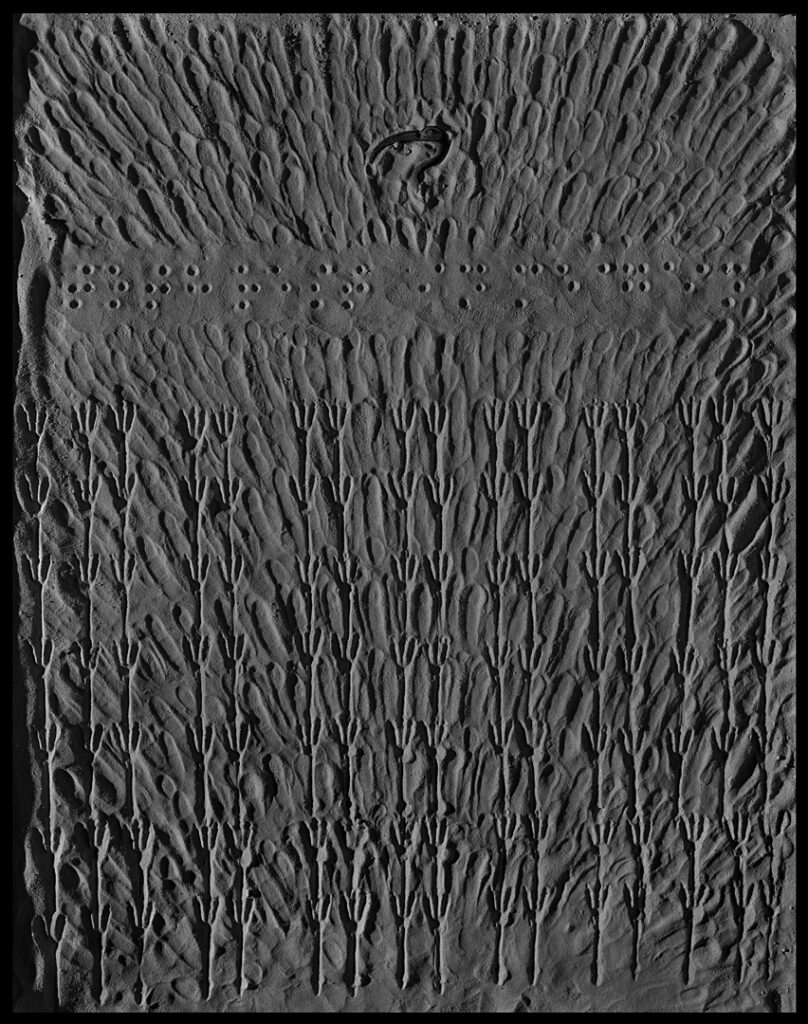
Toth rest in me again
1985 silver gelatin print 19 x 15 inches, 48 x 38 cm
Museum Ludwig, Cologn, Germany
The Detroit Institute of Arts, Detroit, Michigan
Villanova University Collection, Villanova, Pennsylvania
Oklahoma Museum of Art, Oklahoma City, Oklahoma

Bedscape
1984 silver gelatin print 15 x 15 inches, 38 x 38 cm
Musée des Beaux-Arts d’Ixelles, Brussels, Belgium
Boca Raton Museum of Art, Boca Raton, Florida
Museo de Arte Moderno, Bogota, Colombia
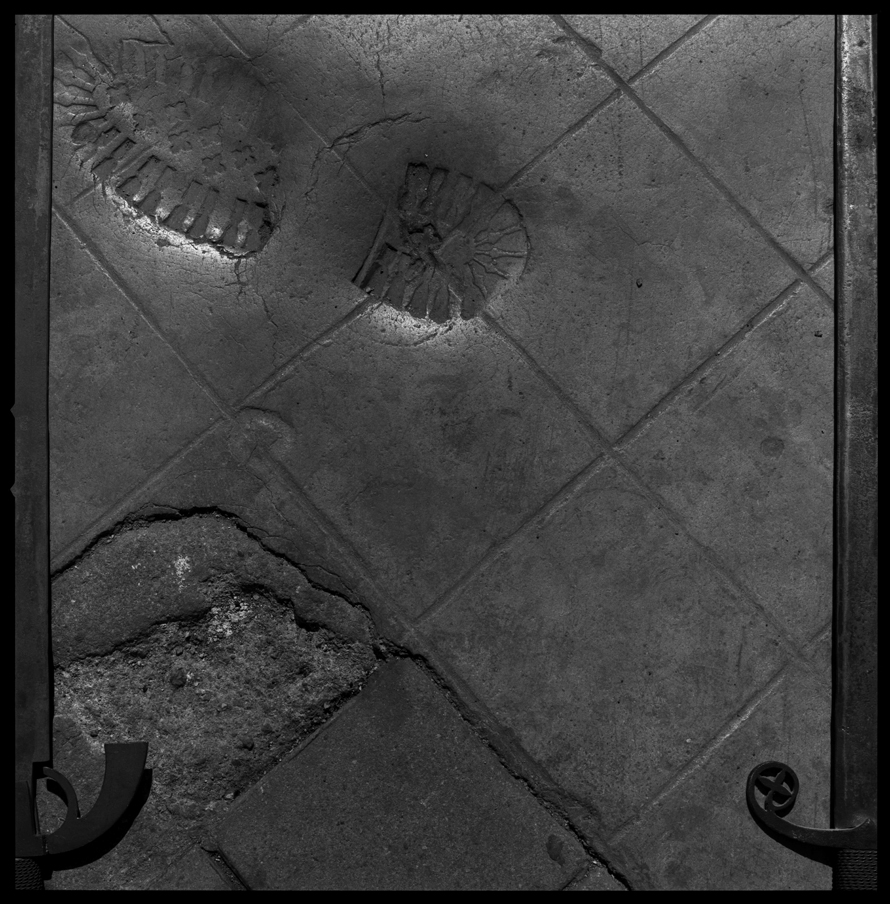
Bootweight I
1984 silver gelatin print 19 x 19 inches, 48 x 48 cm
Corcoran Gallery of Art, Washington, D.C.
Museum Moderner Kunst, Vienna, Austria

La Alhambra
1984 silver gelatin print 15 x 15 inches, 38 x 38 cm
Museo de Arte Contemporáneo – Museo de Santa Cruz, Toledo, Spain
Oklahoma City Museum of Art, Oklahoma City, Oklahoma
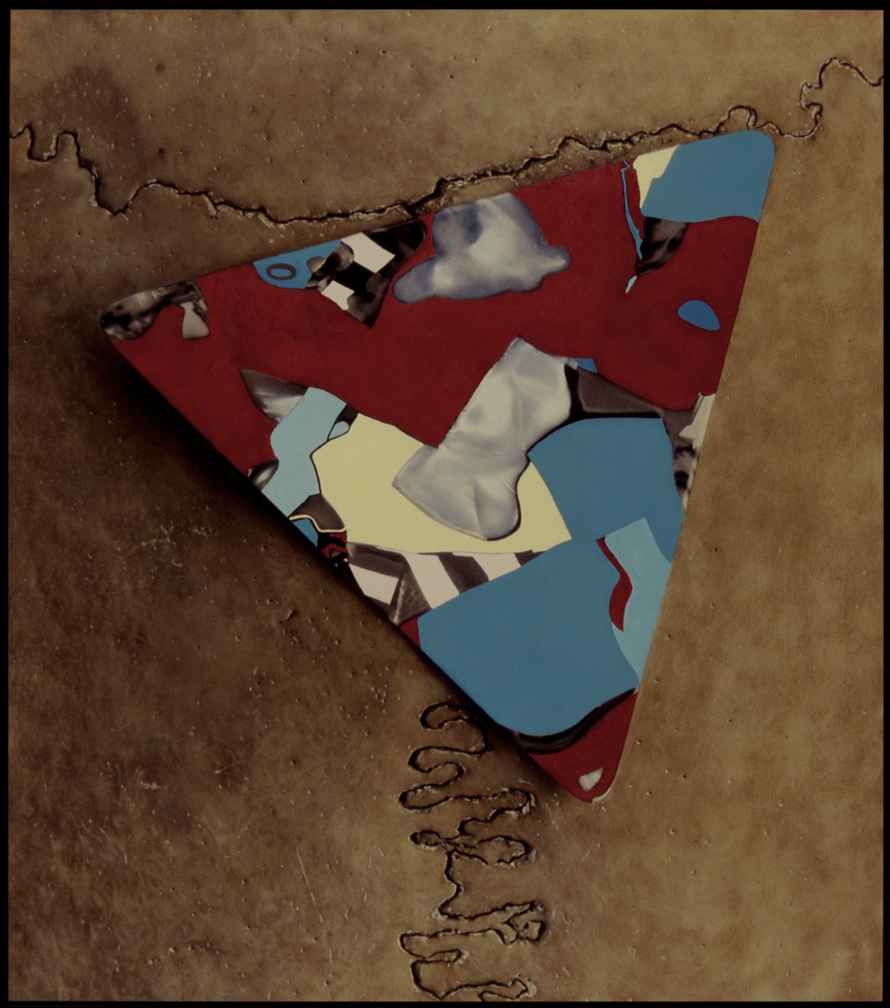
Pick of Many Colors
1983 hand colored silver gelatin print 19 x 19 inches, 48 x 48 cm

Divino Maestro
1982 hand colored silver gelatin print 19 x 15 inches, 48 x 38 cm
Written narrative about this piece
“Ayudame porfavor….”
He was sitting in the gutter right next to the curb where I was standing. I hadn’t noticed him because his dirty hair, skin, and clothes were camouflaged to the color of the Mexican dirt street.
“Help me… I’m stuck!” His manner of speech had a childlike innocence probably due to his provincial Spanish and Zapotec accent. I was musing about other things as he lifted up his hands to me. He wore heavy work gloves and I instinctively grabbed them, and tried to pull him to his feet. But there wasn’t the resistance nor weight that I had expected and he sailed high, as if he was a light-footed ballerina dancing with me. He laughed in an embarrassed sort of way. His legs were missing.
Shocked, I became aware of every detail in the immediate area. At his waist he wore a sock-like garment held together with pins and twine which covered the lower portion of his trunk. There was nothing below that. I lowered him back to his wheeled wooden platform.
I stooped down and lifted the front of his platform onto the curb, and my face came very close to his. All of the details of this man which previously had aroused a feeling of repulsion and disgust began to blur. It must have been due to the intensity of his face and his bright, penetrating eyes. He leaned forward to level himself against the extreme pitch of his platform as I lifted and pushed the back end onto the curb.
The task of getting him up onto the curb was over, and I asked, “Is there anything else I can do?” I expected him to ask for money, and momentarily his eyes retreated and lowered. Shyly he spoke, “My hands…they hurt.”
He held up both gloved hands in a gesture of a scrubbed surgeon trying to avoid touching anything, and he unveiled a gnarled, twisted, and crippled hand; the product of pounding the pavement to propel him on his platform. He took off the other glove to reveal the same horror.
His eyes calmed me, “My hands hurt and I can’t move my fingers very well….please move them, and crack the joints for me.” A wave of numbness engulfed me, while his eyes coaxed me and pleaded with me to lower my guard, to keep in check the fears of intimacy with fellow human beings.
He watched my face the whole time I worked on his hands. His eyes told me when I got in a good crack or when it was time to move onto another joint. Although we exchanged few words, our silent dialogue was lengthy and profound.
With considerable effort he was finally able to flex his hands. His face beaming, he thanked me and then zoomed down the sidewalk on his platform using the full stride of his arms. He stopped just before turning the corner. We waved to each other and then he was gone.
Stephen Althouse
Glove I
Glove II
Gauntlets
Silver Hands
Sacred Hand
Divino Maestro
X-ray I
Shrouded Gauntlet

detail – Divino Maestro

Santa Lucia, I feel you now
1981 silver gelatin print 15 x 15 inches, 38 x 38 cm
Norton Museum of Art, West Palm Beach, Florida
Instituto de Bellas Artes, Cartagena, Colombia
Lehigh University Collection, Bethlehem, Pennsylvania
Oklahoma Museum of Art, Oklahoma City, Oklahoma
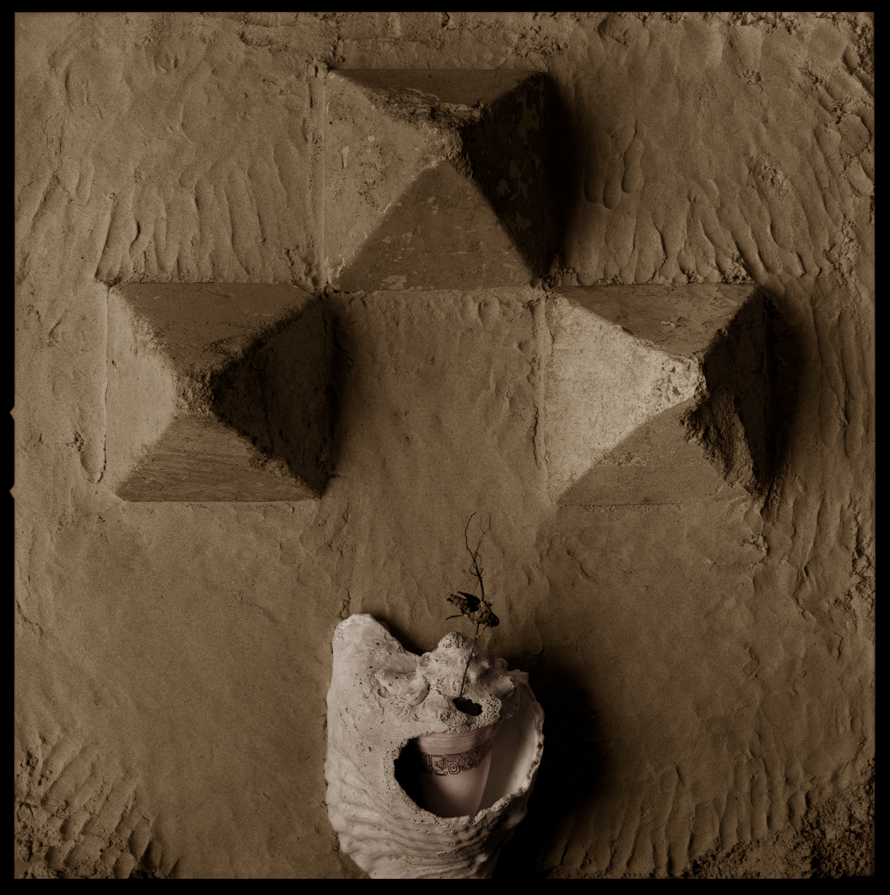
Bare Tree
1980 hand colored silver gelatin print 15 x15 inches, 38 x 38 cm
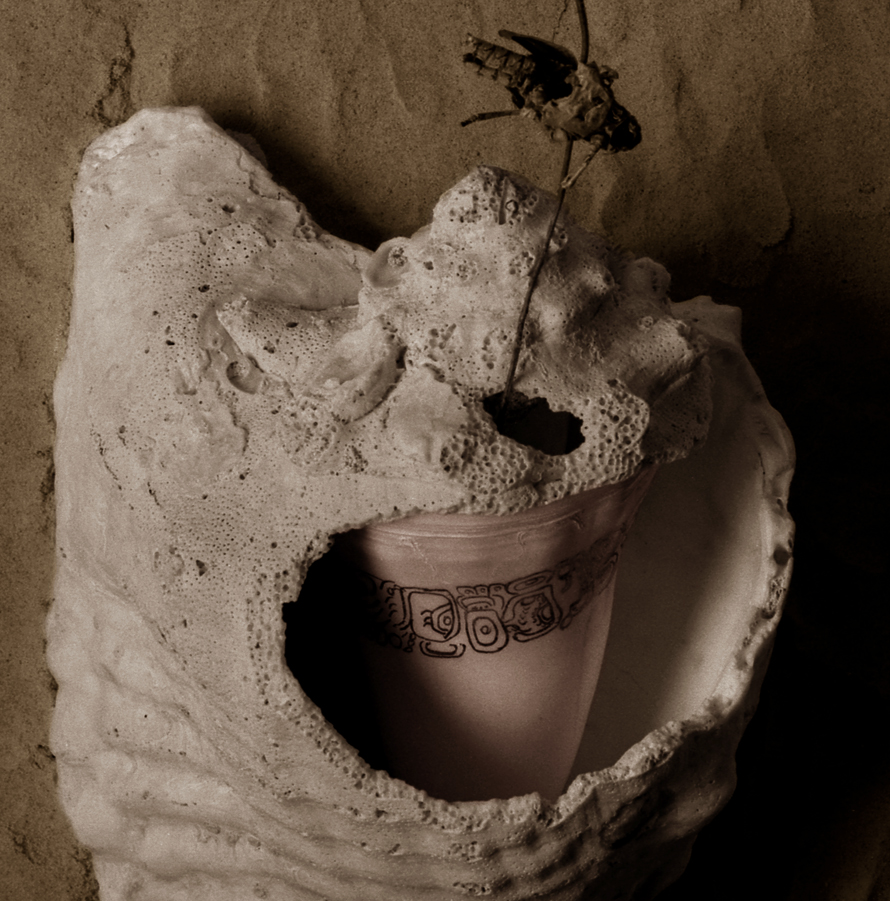
detail – Bare Tree

Zebra Street
1980 silver gelatin print 19 x 15 inches, 48 x 38 cm
Centre d’Art et de Culture Georges-Pompidou, Paris, France
Fogg Museum, Cambridge, Massachusetts
Lehigh University Collection, Bethlehem, Pennsylvania

Eddie lost his Patience
1979 hand colored silver gelatin print 15 x15 inches, 38 x 38 cm
The Royal Photographic Society, Bath, Great Britain
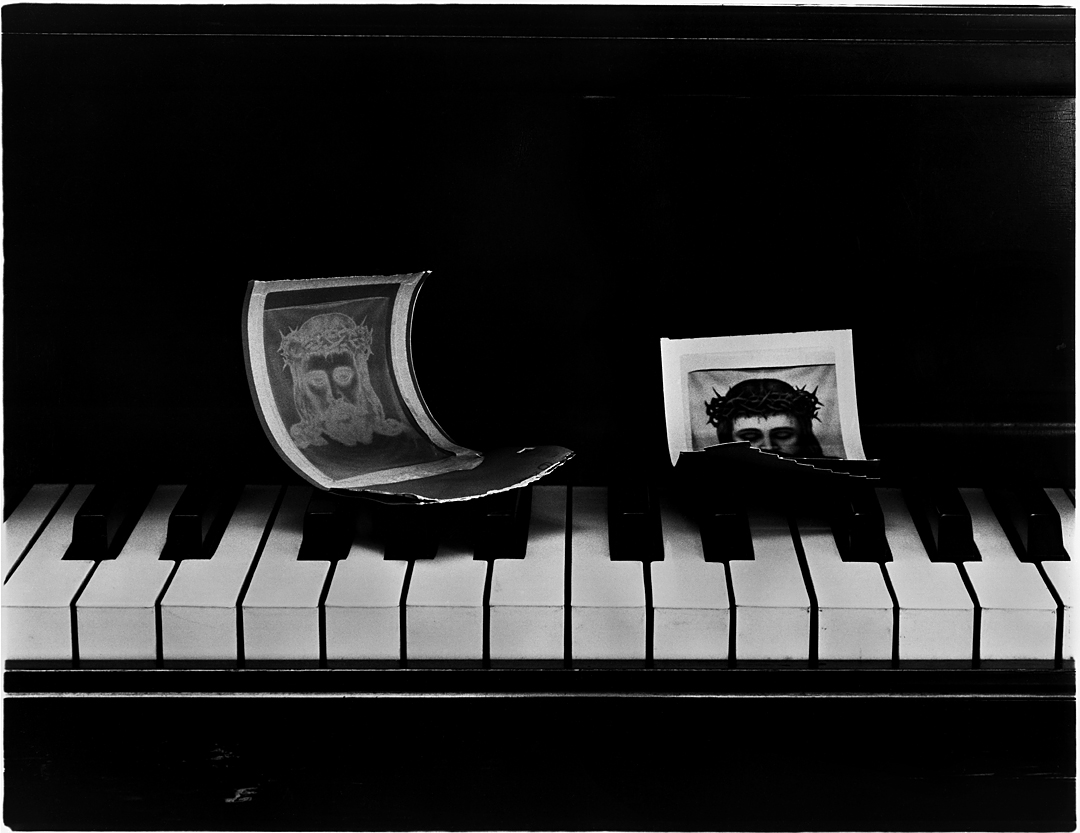
Jesus on the Keyboard
1978 silver gelatin print 10 x 13 inches, 25 x 33 cm
Montgomery Museum of Fine Arts, Montgomery, Alabama
Polaroid International Collection, Cambridge, Massachusett
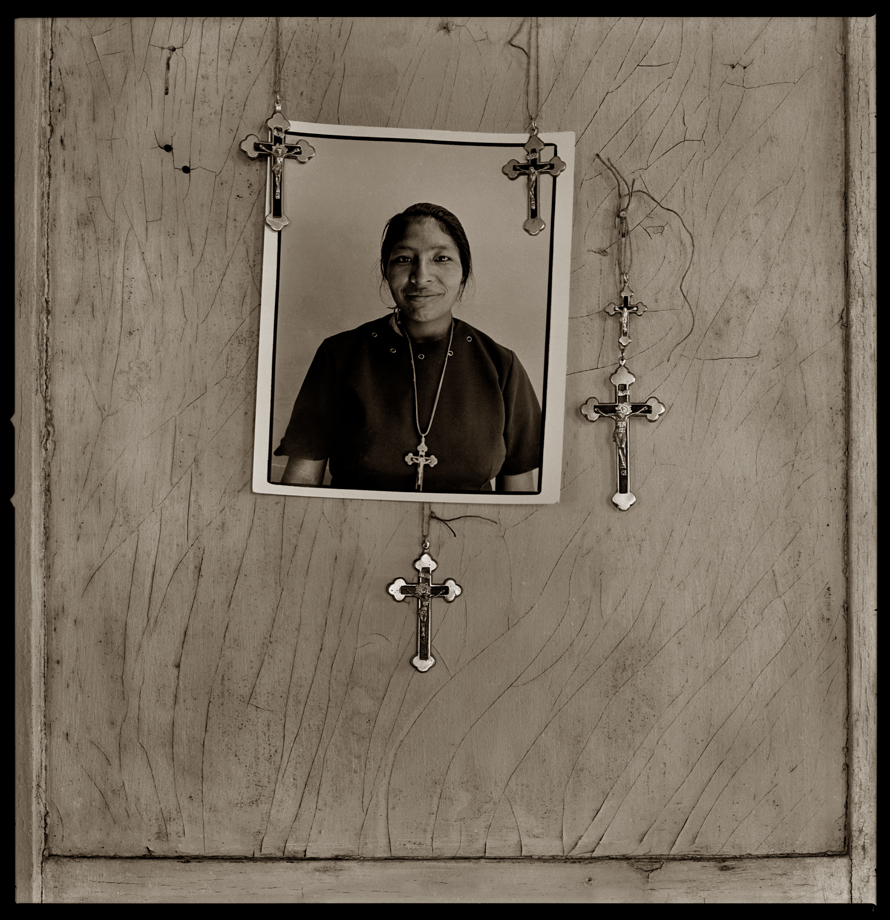
Pancha la Plancha
1978 sepia toned silver gelatin print 15 x 15 inches, 38 x 38 cm
Staatsgalerie Stuttgart, Germany